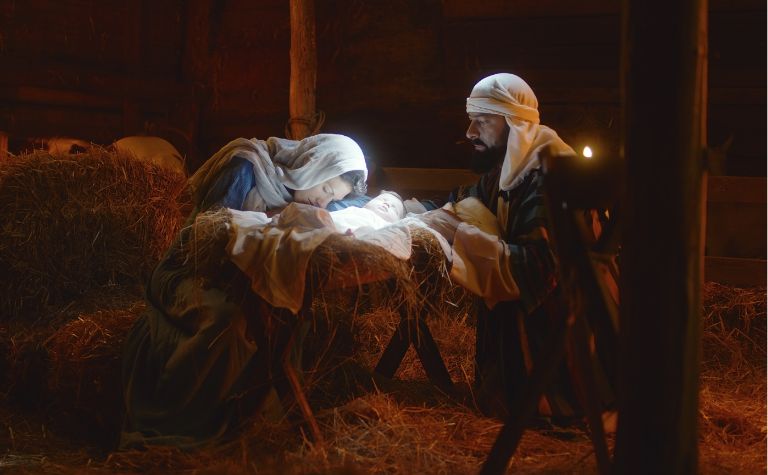The term “Nativity” is often immediately associated with the birth of Jesus Christ and the stories surrounding this event.
Yet, the essence of the word encompasses much more than a single narrative.
It intertwines with diverse cultural traditions, artistic interpretations, and even astrological contexts.
This article unravels the depth and breadth of the term “Nativity,” revealing its multifaceted significance across time and traditions.
From its etymological roots to its global celebrations, discover how humanity has celebrated, interpreted, and cherished the idea of the Nativity through the ages.

Etymology of the Term
The word “Nativity” derives from the Latin term “nativitas,” which means “birth.”
It’s a word that, while specific in its reference in certain contexts, fundamentally pertains to the act of being born.
Across many languages, variations of this term are used to describe birth, revealing its universal application.
Nativity in a Historical Context
Historically, the concept of a significant birth, heralded by omens and celebrated with rituals, is not unique to any one culture.
Ancient civilizations, from the Egyptians to the Greeks, often narrated the miraculous births of their gods and heroes.
Such narratives served as foundations for cultural values, moral codes, and societal structures.
The idea of the Nativity, or a birth of profound importance, has thus been an integral part of human history and storytelling.

The Christian Perspective
Central to Christian tradition is the birth of Jesus Christ in Bethlehem.
Narrated in the Gospels of Matthew and Luke, this story tells of a child born to Mary, a virgin, in a humble setting, and visited by shepherds and magi bearing gifts.
This birth is heralded by a star and announced by angels, emphasizing its significance.
For Christians, the Nativity is not just a historical event but a reflection of God’s love and the promise of hope, redemption, and new beginnings.
Nativity Art and Culture
Over the centuries, the Nativity has been a rich subject in art, music, and literature.
Artists from the Renaissance period to contemporary times have painted scenes capturing the serenity, humility, and wonder of the Nativity.
These artistic renditions often mirror societal norms of the era, with details adapted to resonate with contemporary audiences.
In music, the Nativity has inspired countless hymns and carols, sung in many languages and across cultures.
Literature, too, has seen an abundance of works centered around the Nativity, exploring its themes from various angles.

Modern Interpretations and Celebrations
The way the Nativity is celebrated has evolved over time and varies across cultures and denominations.
While some focus on the re-enactment of the birth scene, others emphasize community gatherings, gift-giving, or acts of kindness.
Advent calendars, Nativity plays, and Christmas cribs are some of the popular traditions associated with the Nativity in modern times.
Furthermore, contemporary retellings of the Nativity story, through films and books, aim to make it relevant for newer generations, highlighting its timeless appeal.
Broader Usage of the Term
Beyond its association with the birth of Jesus, the term “nativity” also refers to circumstances related to any birth.
In the realm of astrology, for instance, a person’s “nativity” or birth chart maps the positions of celestial bodies at their time of birth, believed to influence their traits and destiny.
Such usages underscore the term’s versatility and its overarching theme of beginnings and potentials.
Nativity in Global Celebrations
Across the world, the concept of a special birth or nativity has been integrated into various celebrations, each with its unique customs and traditions.
For example, in parts of Africa, there are festivals celebrating the birth of revered ancestors, recognizing their contributions and the legacy they left behind.
In some Asian cultures, the birth of certain historical or legendary figures is commemorated with grand processions, dance, and music, celebrating their impact on society.
Such celebrations often blend local customs, folklore, and sometimes even elements from the Christian Nativity story, creating a mosaic of traditions that resonate with the local populace.
In Mexico, for instance, “Las Posadas” re-enacts Mary and Joseph’s search for a place to stay through song and community participation.
While it is rooted in the Christian narrative, it has been infused with local Mexican culture and traditions over time.
These global interpretations of nativity reinforce the idea that the birth of an individual, deemed significant for various reasons, is a universally recognized event.
Celebrations associated with these births, much like the Christian Nativity, emphasize values such as hope, renewal, and the potential for positive change.
The Role of Nativity Scenes in Cultural Exchange
Nativity scenes, known in some regions as ‘crèches’ or ‘mangers’, have evolved as remarkable instruments of cultural exchange.
These dioramas depicting the birth of Jesus often integrate elements from the locales in which they’re crafted.
For example, in parts of South America, nativity scenes might feature local fauna like llamas instead of the traditional sheep.
In regions of Africa, the Holy Family might be portrayed with traditional African attire, celebrating both the Nativity story and local heritage.
In Italy, particularly in Naples, intricate nativity scenes called ‘presepi’ are created, with not just the central characters but also an extensive depiction of daily life, reflecting Neapolitan culture of the 18th century.
Similarly, in parts of the Philippines, the ‘Belen’ showcases Filipino village life alongside the Nativity, with figurines sometimes made of indigenous materials like abaca.
The creation and sharing of these unique nativity scenes provide an avenue for different cultures to represent and share their identity while also participating in a universally recognized story.
It’s a beautiful demonstration of how the same story, when passed through the lens of various cultures, can be retold in myriad ways, each iteration enriching the narrative even further.
Conclusion
The concept of the Nativity, in its essence, transcends cultural and chronological boundaries.
While closely tied to the Christian narrative of Jesus’s birth, its significance, rooted in the universal theme of celebrated births, has been reflected in various traditions, arts, and disciplines.
The term “Nativity,” with its layered meanings and applications, serves as a reminder of the reverence humanity holds for new beginnings, hope, and the narratives that shape civilizations.
Related Questions
Joseph, the husband of Mary and the earthly father of Jesus Christ, is depicted in the Gospels as humble, law-abiding, and obedient. In many Christmas scenes, such as in displays of the manger, he is...
The virgin Mary, the mother of Jesus, is one of the most fascinating people in the Bible. For 2,000 years, people of different eras and cultures have marveled at her faith in God. Mary's story in the...
